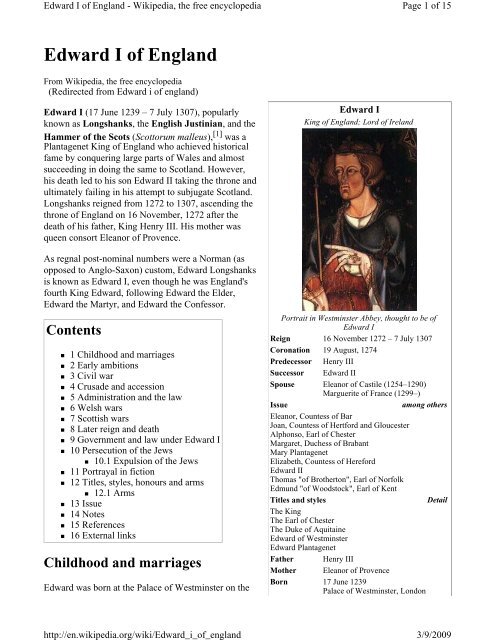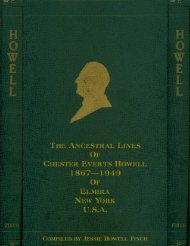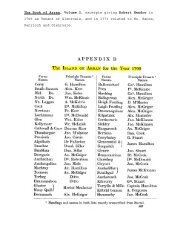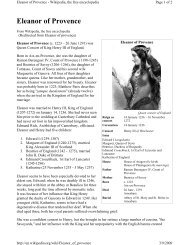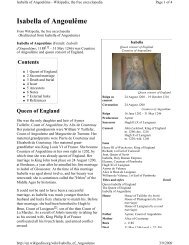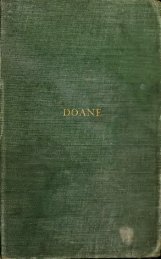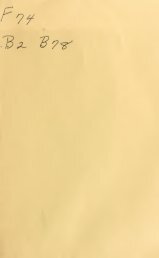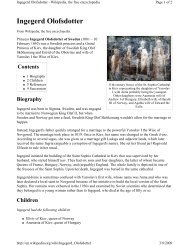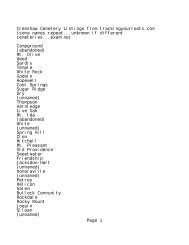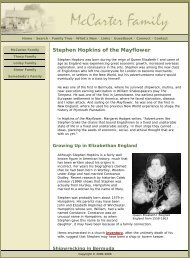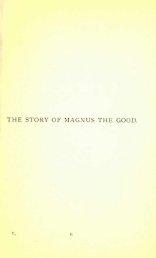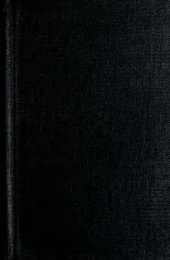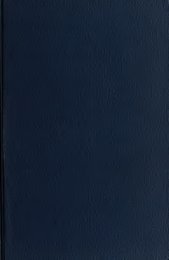Edward I "Longshanks" King of England - Adkins-Horton Genealogy
Edward I "Longshanks" King of England - Adkins-Horton Genealogy
Edward I "Longshanks" King of England - Adkins-Horton Genealogy
You also want an ePaper? Increase the reach of your titles
YUMPU automatically turns print PDFs into web optimized ePapers that Google loves.
<strong>Edward</strong> I <strong>of</strong> <strong>England</strong> - Wikipedia, the free encyclopedia<br />
<strong>Edward</strong> I <strong>of</strong> <strong>England</strong><br />
From Wikipedia, the free encyclopedia<br />
(Redirected from <strong>Edward</strong> i <strong>of</strong> england)<br />
<strong>Edward</strong> I (17 June 1239 – 7 July 1307), popularly<br />
known as Longshanks, the English Justinian, and the<br />
Hammer <strong>of</strong> the Scots (Scottorum malleus), [1] was a<br />
Plantagenet <strong>King</strong> <strong>of</strong> <strong>England</strong> who achieved historical<br />
fame by conquering large parts <strong>of</strong> Wales and almost<br />
succeeding in doing the same to Scotland. However,<br />
his death led to his son <strong>Edward</strong> II taking the throne and<br />
ultimately failing in his attempt to subjugate Scotland.<br />
Longshanks reigned from 1272 to 1307, ascending the<br />
throne <strong>of</strong> <strong>England</strong> on 16 November, 1272 after the<br />
death <strong>of</strong> his father, <strong>King</strong> Henry III. His mother was<br />
queen consort Eleanor <strong>of</strong> Provence.<br />
As regnal post-nominal numbers were a Norman (as<br />
opposed to Anglo-Saxon) custom, <strong>Edward</strong> Longshanks<br />
is known as <strong>Edward</strong> I, even though he was <strong>England</strong>'s<br />
fourth <strong>King</strong> <strong>Edward</strong>, following <strong>Edward</strong> the Elder,<br />
<strong>Edward</strong> the Martyr, and <strong>Edward</strong> the Confessor.<br />
Contents<br />
1 Childhood and marriages<br />
2 Early ambitions<br />
3 Civil war<br />
4 Crusade and accession<br />
5 Administration and the law<br />
6 Welsh wars<br />
7 Scottish wars<br />
8 Later reign and death<br />
9 Government and law under <strong>Edward</strong> I<br />
10 Persecution <strong>of</strong> the Jews<br />
10.1 Expulsion <strong>of</strong> the Jews<br />
11 Portrayal in fiction<br />
12 Titles, styles, honours and arms<br />
12.1 Arms<br />
13 Issue<br />
14 Notes<br />
15 References<br />
16 External links<br />
Childhood and marriages<br />
<strong>Edward</strong> was born at the Palace <strong>of</strong> Westminster on the<br />
http://en.wikipedia.org/wiki/<strong>Edward</strong>_i_<strong>of</strong>_england<br />
<strong>Edward</strong> I<br />
<strong>King</strong> <strong>of</strong> <strong>England</strong>; Lord <strong>of</strong> Ireland<br />
Page 1 <strong>of</strong> 15<br />
Portrait in Westminster Abbey, thought to be <strong>of</strong><br />
<strong>Edward</strong> I<br />
Reign 16 November 1272 – 7 July 1307<br />
Coronation 19 August, 1274<br />
Predecessor Henry III<br />
Successor <strong>Edward</strong> II<br />
Spouse Eleanor <strong>of</strong> Castile (1254–1290)<br />
Marguerite <strong>of</strong> France (1299–)<br />
Issue among others<br />
Eleanor, Countess <strong>of</strong> Bar<br />
Joan, Countess <strong>of</strong> Hertford and Gloucester<br />
Alphonso, Earl <strong>of</strong> Chester<br />
Margaret, Duchess <strong>of</strong> Brabant<br />
Mary Plantagenet<br />
Elizabeth, Countess <strong>of</strong> Hereford<br />
<strong>Edward</strong> II<br />
Thomas "<strong>of</strong> Brotherton", Earl <strong>of</strong> Norfolk<br />
Edmund "<strong>of</strong> Woodstock", Earl <strong>of</strong> Kent<br />
Titles and styles Detail<br />
The <strong>King</strong><br />
The Earl <strong>of</strong> Chester<br />
The Duke <strong>of</strong> Aquitaine<br />
<strong>Edward</strong> <strong>of</strong> Westminster<br />
<strong>Edward</strong> Plantagenet<br />
Father Henry III<br />
Mother Eleanor <strong>of</strong> Provence<br />
Born 17 June 1239<br />
Palace <strong>of</strong> Westminster, London<br />
3/9/2009
<strong>Edward</strong> I <strong>of</strong> <strong>England</strong> - Wikipedia, the free encyclopedia<br />
night <strong>of</strong> 17/18 June 1239, to <strong>King</strong> Henry III and<br />
Eleanor <strong>of</strong> Provence. [2] Henry was devoted to the cult<br />
<strong>of</strong> <strong>Edward</strong> the Confessor, and for this reason decided to<br />
name his firstborn son <strong>Edward</strong> – not a common name<br />
among the English aristocracy at the time. [3] <strong>Edward</strong> was in the care <strong>of</strong> Hugh Giffard – father <strong>of</strong> the<br />
future Chancellor Godfrey Giffard – until Bartholomew Pecche took over at Giffard's death in 1246. [4]<br />
Among his childhood companions was his cousin Henry <strong>of</strong> Almain, son <strong>of</strong> <strong>King</strong> Henry’s brother Richard<br />
<strong>of</strong> Cornwall. [5]<br />
In 1254 there were fears that Castile might invade the English province <strong>of</strong> Gascony. As a preventive<br />
measure, it was agreed that <strong>Edward</strong> should marry Eleanor, half-sister <strong>of</strong> <strong>King</strong> Alfonso X <strong>of</strong> Castile. [6] As<br />
part <strong>of</strong> the marriage agreement, Alfonso insisted that grants <strong>of</strong> land worth 15,000 marks a year be made to<br />
the young prince, not yet fifteen years <strong>of</strong> age. [7] Though the endowments <strong>King</strong> Henry made were<br />
sizeable, the independence they provided for <strong>Edward</strong> was limited. He had already received Gascony as<br />
early as 1249, but Simon de Montfort, 6th Earl <strong>of</strong> Leicester had been appointed to serve as royal<br />
lieutenant there the year before, so in practice <strong>Edward</strong> derived neither authority nor revenue from this<br />
province. [8] The grant he received in 1254 included most <strong>of</strong> Ireland, and much land in Wales and<br />
<strong>England</strong>, including the earldom <strong>of</strong> Chester. [9] The king maintained much control <strong>of</strong> the land in question,<br />
however, and particularly in Ireland was <strong>Edward</strong>’s power limited. [10]<br />
Eleanor and <strong>Edward</strong> were married on 1 November 1254 in the monastery <strong>of</strong> Las Huelgas in Castile. [11]<br />
They would go on to have at least fifteen (possibly sixteen) children, [12] and her death in 1290 affected<br />
<strong>Edward</strong> deeply. He displayed his grief by erecting the Eleanor crosses, one at each place where her<br />
funeral cortège stopped for the night. [13] His second marriage (at the age <strong>of</strong> 60) at Canterbury on 10<br />
September 1299, to Marguerite <strong>of</strong> France (aged 17 and known as the "Pearl <strong>of</strong> France" by her husband's<br />
English subjects), the daughter <strong>of</strong> <strong>King</strong> Philip III <strong>of</strong> France (Phillip the Bold) and Maria <strong>of</strong> Brabant,<br />
produced three children.<br />
In the years from 1254 to 1257, <strong>Edward</strong> was under the influence <strong>of</strong> the court faction known as the<br />
Savoyards, relatives <strong>of</strong> his mother, Eleanor <strong>of</strong> Provence. [14] The most notable <strong>of</strong> this group was Peter <strong>of</strong><br />
Savoy, the queen’s uncle. [15] From 1257 onwards, he increasingly fell in with the Poitevin, or Lusignan<br />
faction – the king's half-brothers – led by men such as William de Valence. [16] Both these groups were<br />
considered privileged foreigners, and were deeply resented by the established English aristocracy. [17]<br />
Early ambitions<br />
Died 7 July 1307 (aged 68)<br />
Burgh by Sands, Cumberland<br />
Burial Westminster Abbey, London<br />
Page 2 <strong>of</strong> 15<br />
<strong>Edward</strong> had shown independence in political matters as early as 1255 when he took sides in a local<br />
conflict in Gascony, contrary to his father’s policy <strong>of</strong> mediation. [18] In May 1258 a group <strong>of</strong> magnates<br />
drew up a document for reform <strong>of</strong> the king’s government – the so-called Provisions <strong>of</strong> Oxford – largely<br />
directed against the Lusignans. <strong>Edward</strong> stood by his political allies, and strongly opposed the Provisions.<br />
The reform movement had success, however, and gradually <strong>Edward</strong>’s attitude started to change. In March<br />
1259 he entered into a formal alliance with one <strong>of</strong> the main reformers Richard de Clare, earl <strong>of</strong><br />
Gloucester. Then, on 15 October, 1259 he announced that he supported the barons' goals, and their leader,<br />
Simon de Montfort. [19]<br />
The motive behind <strong>Edward</strong>’s change <strong>of</strong> heart could have been purely pragmatic; Montfort was in a good<br />
position to support his cause in Gascony. [20] When the king left for France in November, <strong>Edward</strong>'s<br />
behaviour turned into pure insubordination, as he made several appointments to advance the cause <strong>of</strong> the<br />
http://en.wikipedia.org/wiki/<strong>Edward</strong>_i_<strong>of</strong>_england<br />
3/9/2009
<strong>Edward</strong> I <strong>of</strong> <strong>England</strong> - Wikipedia, the free encyclopedia<br />
reformers. <strong>King</strong> Henry started believing that his son was plotting to depose him. [21] When the king<br />
returned he initially refused to see his son, but through the mediation <strong>of</strong> the Earl <strong>of</strong> Cornwall and the<br />
archbishop <strong>of</strong> Canterbury the two were eventually reconciled. [22] <strong>Edward</strong> was sent abroad, and in<br />
November 1260 he once more united with the Lusignans, who had been exiled to France. [23]<br />
Back in <strong>England</strong>, early in 1262, <strong>Edward</strong> fell out with some <strong>of</strong> his former allies over financial matters. A<br />
year later he led a campaign in Wales against Llywelyn ap Gruffudd, with limited results. [24] Around the<br />
same time Simon de Montfort, who had been out <strong>of</strong> the country since 1261, returned to <strong>England</strong> and<br />
reignited the baronial reform movement. [25] The king gave in to the barons’ demands, but <strong>Edward</strong> – who<br />
was now firmly on the side <strong>of</strong> his father – held out. He reunited with some <strong>of</strong> the men he had alienated<br />
the year before – among them Henry <strong>of</strong> Almain and John de Warenne, Earl <strong>of</strong> Surrey – and retook<br />
Windsor Castle from the rebels. [26] Through the arbitration <strong>of</strong> the <strong>King</strong> Louis IX <strong>of</strong> France, an agreement<br />
was made between the two parties. This so-called Mise <strong>of</strong> Amiens was largely favourable to the royalist<br />
side, and laid the seeds for further conflict. [27]<br />
Civil war<br />
The years 1264–1267 saw the conflict known as the Barons' War, where baronial forces led by Simon de<br />
Montfort fought against those who remained loyal to the king. [28] The first scene <strong>of</strong> battle was the city <strong>of</strong><br />
Gloucester, which <strong>Edward</strong> managed to retake from the enemy. When Robert de Ferrers, earl <strong>of</strong> Derby,<br />
came to the assistance <strong>of</strong> the rebels, <strong>Edward</strong> negotiated a truce with the earl, the terms <strong>of</strong> which he later<br />
broke. <strong>Edward</strong> then proceeded to capture Northampton from Montfort's son Simon, before embarking on<br />
a retaliatory campaign against Derby's lands. [29] The baronial and royalist forces finally met at the Battle<br />
<strong>of</strong> Lewes, on 14 May 1264. <strong>Edward</strong>'s forces performed well, but the king's army nevertheless lost the<br />
battle. <strong>Edward</strong>, along with his cousin Henry <strong>of</strong> Almein, was given up as prisoners to Montfort. [30]<br />
<strong>Edward</strong> remained in captivity until March, and even after his release he was kept under strict<br />
surveillance. [31] Then, on 28 May, he managed to escape his custodians, and joined up with the earl <strong>of</strong><br />
Gloucester, who had recently defected to the king's side. [32] Montfort's support was now dwindling, and<br />
<strong>Edward</strong> retook Worcester and Gloucester with relative little effort. [33] In the meanwhile, Montfort had<br />
made an alliance with Llywelyn, and started moving east to join forces with his son Simon. <strong>Edward</strong><br />
managed to make a surprise attack at Kenilworth Castle, where the younger Montfort was quartered,<br />
before moving on to cut <strong>of</strong>f the earl <strong>of</strong> Leicester. [34] The two forces then met at the second great<br />
encounter <strong>of</strong> the Barons' War – the Battle <strong>of</strong> Evesham, on 4 August 1265. Montfort stood little chance<br />
against the superior royal forces, and after his defeat he was killed and mutilated in the field. [35]<br />
Medieval manuscript showing<br />
Simon de Montfort's mutilated<br />
body at the field <strong>of</strong> Evesham.<br />
Page 3 <strong>of</strong> 15<br />
The war was not over with Montfort's death, and <strong>Edward</strong> participated in<br />
the continued campaigning. At Christmas he came to terms with the<br />
younger Simon de Montfort and his associates in the Isle <strong>of</strong> Axholme in<br />
Lincolnshire, and in March he led a successful assault on the Cinque<br />
Ports. [36] A contingent <strong>of</strong> rebels held out in the virtually impregnable<br />
Kenilworth Castle, and did not surrender until the drafting <strong>of</strong> the<br />
conciliatory Dictum <strong>of</strong> Kenilworth. [37] In April it seemed as if<br />
Gloucester would take up the cause <strong>of</strong> the reform movement, and civil<br />
war would return, but after a renegotiation <strong>of</strong> the terms <strong>of</strong> the Dictum <strong>of</strong> Kenilworth the parties came to<br />
an agreement. [38] <strong>Edward</strong>, however, was little involved in the settlement negotiations following the wars;<br />
at this point his main focus was on planning his upcoming crusade. [39]<br />
http://en.wikipedia.org/wiki/<strong>Edward</strong>_i_<strong>of</strong>_england<br />
3/9/2009
<strong>Edward</strong> I <strong>of</strong> <strong>England</strong> - Wikipedia, the free encyclopedia<br />
Crusade and accession<br />
[40]<br />
See also: Eighth Crusade and Ninth Crusade<br />
<strong>Edward</strong> took the cross in an elaborate ceremony on 24 June 1268, along with his brother Edmund and<br />
cousin Henry <strong>of</strong> Almain. Among others who committed themselves to the cause were former adversaries<br />
like the earl <strong>of</strong> Gloucester, though the earl did not end up going. [41] With the country pacified, the<br />
greatest impediment to the project was providing sufficient finances. [42] <strong>King</strong> Louis IX <strong>of</strong> France, who<br />
was the leader <strong>of</strong> the crusade, provided a loan <strong>of</strong> about £17,500. [43] This, however, was not enough; the<br />
rest had to be raised through a lay tax, something which had not happened since 1237. [43] In May 1270,<br />
parliament granted a tax <strong>of</strong> a twentieth, [44] in exchange for which the king agreed to reconfirm Magna<br />
Carta, and to impose restrictions on Jewish money lending. [45] On 20 August <strong>Edward</strong> sailed from Dover<br />
for France. [46] It is impossible to determine the size <strong>of</strong> the force with any certainty, but <strong>Edward</strong> probably<br />
brought with him around 225 knights and all together less than 1000 men. [42]<br />
The original goal <strong>of</strong> the crusade was to relieve the beleaguered Christian stronghold <strong>of</strong> Acre, but Louis<br />
had been diverted to Tunis. The French king and his brother Charles <strong>of</strong> Anjou, who had made himself<br />
king <strong>of</strong> Sicily, decided to attack the emirate in order to establish a stronghold in North Africa. [47] The<br />
plans failed when the French forces were struck by an epidemic which, on 25 August, took the life <strong>of</strong><br />
<strong>King</strong> Louis himself. [48] By the time <strong>Edward</strong> arrived at Tunis, Charles had already signed a treaty with the<br />
emir, and there was little else to do than to return to Sicily. The crusade was postponed until next spring,<br />
but a devastating storm <strong>of</strong>f the coast <strong>of</strong> Sicily dissuaded Charles <strong>of</strong> Anjou and Louis's successor Philip III<br />
from any further campaigning. [49] <strong>Edward</strong> decided to continue alone, and on 9 May 1271 he finally<br />
landed at Acre. [50]<br />
The situation in the Holy Land at the time <strong>of</strong> <strong>Edward</strong>'s arrival was a<br />
precarious one. Jerusalem had fallen in 1187, and Acre was now the<br />
centre <strong>of</strong> the Christian state. [51] The Muslim states were on the <strong>of</strong>fensive<br />
under the Mamluk leadership <strong>of</strong> Baibars, and were now threatening<br />
Acre itself. Though <strong>Edward</strong>'s men were an important addition to the<br />
garrison, they stood little chance against Baibars' superior forces, and an<br />
initial raid at nearby St Georges-de-Lebeyne in June was largely futile.<br />
[52] An embassy to the Mongols helped bring about an attack on Aleppo<br />
in the north, allowing the crusading armies a distraction. [53] In<br />
November, <strong>Edward</strong> led a raid on Qaqun, which could have served as a<br />
bridgehead to Jerusalem, but both the Mongol invasion and the attack on<br />
Qaqun failed. Things now seemed increasingly desperate, and in May<br />
1272 Hugh III <strong>of</strong> Cyprus, who was the nominal king <strong>of</strong> Jerusalem,<br />
signed a ten-year truce with Baibars. [54] <strong>Edward</strong> was initially defiant,<br />
but an attack by a Muslim assassin in June forced him to abandon any<br />
Page 4 <strong>of</strong> 15<br />
Operations during the Crusade<br />
<strong>of</strong> <strong>Edward</strong> I.<br />
further campaigning. Even though he managed to kill the assassin, he was struck in the arm by a poisoned<br />
dagger, and became strongly reduced physically over the next months. [55]<br />
It was not until 24 September that <strong>Edward</strong> left Acre. Arriving in Sicily, he was met with the news that<br />
Henry III had died on 16 November. [56] <strong>Edward</strong> was deeply saddened by these news, but rather than<br />
hurrying home at once, he made a leisurely journey northwards. This was partly due to his health still<br />
http://en.wikipedia.org/wiki/<strong>Edward</strong>_i_<strong>of</strong>_england<br />
3/9/2009
<strong>Edward</strong> I <strong>of</strong> <strong>England</strong> - Wikipedia, the free encyclopedia<br />
being poor, but also due to a lack <strong>of</strong> urgency. [57] The political situation in <strong>England</strong> was stable after the<br />
mid-century upheavals, and <strong>Edward</strong> was proclaimed king at his father's death, rather than at his own<br />
coronation, as had up until then been customary. [58] The new king embarked on an overland journey<br />
through Italy and France, where among other things he visited the pope in Rome and suppressed a<br />
rebellion in Gascony. [59] Only on 2 August 1274 did he return to <strong>England</strong>, and was crowned on 19<br />
August. [60]<br />
Administration and the law<br />
Page 5 <strong>of</strong> 15<br />
Upon returning home, <strong>Edward</strong> immediately embarked on the<br />
administrative business <strong>of</strong> the nation, and his major concern was<br />
restoring order and re-establishing royal authority after the disastrous<br />
reign <strong>of</strong> his father. [61] In order to accomplish this he immediately<br />
ordered an extensive change <strong>of</strong> administrative personnel. The most<br />
important <strong>of</strong> these was the appointment <strong>of</strong> Robert Burnell as chancellor;<br />
a man who would remain in the post until 1292, as one <strong>of</strong> the king's<br />
closest associates. [62] <strong>Edward</strong> then proceeded to replace most local<br />
<strong>of</strong>ficials, such as the escheators and sheriffs. [63] This last measure was done in preparation for an<br />
extensive inquest covering all <strong>of</strong> <strong>England</strong>, that would hear complaints about abuse <strong>of</strong> power by royal<br />
<strong>of</strong>ficers. The inquest produced the so-called Hundred Rolls, from the administrative sub-division <strong>of</strong> the<br />
hundred. [64]<br />
Groat <strong>of</strong> <strong>Edward</strong> I (4 pence)<br />
The second purpose <strong>of</strong> the inquest was to establish what land and rights the crown had lost during the<br />
reign <strong>of</strong> Henry III. [65] The Hundred Rolls formed the basis for the later legal inquiries called the Quo<br />
warranto proceedings. The purpose <strong>of</strong> these inquiries was to establish by what warrant (Latin: Quo<br />
warranto) various liberties were held. [66] If the defendant could not produce a royal licence to prove the<br />
grant <strong>of</strong> the liberty, then it was the crown's opinion – based on the writings <strong>of</strong> Bracton – that the liberty<br />
should revert to the king. This caused great consternation among the aristocracy, who insisted that long<br />
use in itself constituted license. [67] A compromise was eventually reached in 1290, whereby a liberty was<br />
considered legitimate as long as it could be shown to have been exercised since the coronation <strong>of</strong> <strong>King</strong><br />
Richard I, in 1189. [68] Royal gains from the Quo warranto proceedings were insignificant; few liberties<br />
were returned to the king. [69] <strong>Edward</strong> had nevertheless won a significant victory, in clearly establishing<br />
the principle that all liberties essentially emanated from the king. [70]<br />
The 1290 Statute <strong>of</strong> Quo warranto was only one part <strong>of</strong> a wider legislative effort, which was one <strong>of</strong> the<br />
most important contributions <strong>of</strong> <strong>Edward</strong> I's reign. [5] This era <strong>of</strong> legislative action had started already at<br />
the time <strong>of</strong> the baronial reform movement; the Statute <strong>of</strong> Marlborough (1267) contained elements both <strong>of</strong><br />
the Provisions <strong>of</strong> Oxford and the Dictum <strong>of</strong> Kenilworth. [71] The compilation <strong>of</strong> the Hundred Rolls was<br />
followed shortly after by the issue <strong>of</strong> Westminster I (1275), which asserted the royal prerogative and<br />
outlined restrictions on liberties. [72] In Mortmain (1279), the issue was grants <strong>of</strong> land to the church. [73]<br />
The first clause <strong>of</strong> Westminster II (1285), known as De donis conditionalibus, dealt with family<br />
settlement <strong>of</strong> land, and entails. [74] Merchants (1285) established firm rules for the recovery <strong>of</strong> debts, [75]<br />
while Winchester (1285) dealt with peacekeeping on a local level. [76] Quia emptores (1290) – issued<br />
along with Quo warranto – set out to remedy land ownership disputes resulting from alienation <strong>of</strong> land<br />
by subinfeudation. [77] The age <strong>of</strong> the great statutes largely ended with the death <strong>of</strong> Robert Burnell in<br />
1292. [78]<br />
http://en.wikipedia.org/wiki/<strong>Edward</strong>_i_<strong>of</strong>_england<br />
3/9/2009
<strong>Edward</strong> I <strong>of</strong> <strong>England</strong> - Wikipedia, the free encyclopedia<br />
Welsh wars<br />
Llywelyn ap Gruffydd enjoyed an advantageous situation in the aftermath <strong>of</strong> the Barons' War. Through<br />
the 1267 Treaty <strong>of</strong> Montgomery he obtained much land in the Marches, and was recognised in his title <strong>of</strong><br />
Prince <strong>of</strong> Wales. [79] Armed conflicts nevertheless continued, in particular with certain dissatisfied<br />
Marcher Lords, such as the earl <strong>of</strong> Gloucester, Roger Mortimer and Humphrey de Bohun, Earl <strong>of</strong><br />
Hereford. [80] Problems were exacerbated when his younger brother Dafydd and Gruffydd ap<br />
Gwenwynwyn <strong>of</strong> Powys, after a failed assassination attempt against Llywelyn, defected to the English in<br />
1274. [81] Citing ongoing hostilities and the English king harbouring his enemies, Llywelyn refused to do<br />
homage to <strong>Edward</strong>. [82] For <strong>Edward</strong>, a further provocation came in the form <strong>of</strong> Llywelyn's planned<br />
marriage to Eleanor, daughter <strong>of</strong> Simon de Montfort. [83] In November 1276 war was declared. [84] Initial<br />
operations were launched under the captaincy <strong>of</strong> Mortimer, Lancaster (<strong>Edward</strong>'s brother Edmund) and<br />
William de Beauchamp, Earl <strong>of</strong> Warwick. [85] Support for Llywelyn was weak among his own<br />
countrymen. [86] In July 1277 <strong>Edward</strong> invaded with a force <strong>of</strong> 15,500 – <strong>of</strong> whom 9,000 were Welshmen.<br />
[87] The campaign never came to a major battle, and Llywelyn soon realised he had no choice but to<br />
surrender. [87] By the Treaty <strong>of</strong> Aberconwy in November 1277, he was left only with the land <strong>of</strong><br />
Gwynedd, though he was allowed to retain the title <strong>of</strong> Prince <strong>of</strong> Wales. [88]<br />
When war broke out again in 1282, it was an entirely different undertaking. For the Welsh this was a war<br />
<strong>of</strong> national independence with wide support, provoked particularly by attempts to impose English law on<br />
Welsh subjects. [89] For <strong>Edward</strong> it became a war <strong>of</strong> conquest rather than simply a punitive expedition, like<br />
the former campaign. [90] The war started with a rebellion by Dafydd, who was discontent with the reward<br />
his had received from <strong>Edward</strong> in 1277. [91] Llywelyn and other Welsh chieftains soon joined in, and<br />
initially the Welsh experienced military success. In June, Gloucester was defeated at the Battle <strong>of</strong><br />
Llandeilo Fawr. [92] On 6 November, while John Peckham, archbishop <strong>of</strong> Canterbury, was conducting<br />
peace negotiations, <strong>Edward</strong>'s commander <strong>of</strong> Anglesey, Luke de Tany, decided to carry out a surprise<br />
attack. A pontoon bridge had been built to the mainland, but shortly after Tany and his men crossed over,<br />
they were ambushed by the Welsh, and suffered heavy losses at the Battle <strong>of</strong> Moel-y-don. [93] The Welsh<br />
advances ended on December 11, however, when Llywelyn was lured into a trap and killed at the Battle<br />
<strong>of</strong> Orewin Bridge. [94] The submission <strong>of</strong> Wales was complete with the capture in April 1283 <strong>of</strong> Dafydd,<br />
who was taken to Shrewsbury and executed as a traitor. [95]<br />
Caernarfon Castle, one <strong>of</strong> the<br />
most imposing <strong>of</strong> <strong>Edward</strong>'s<br />
Welsh castles.<br />
Page 6 <strong>of</strong> 15<br />
Further rebellions occurred in 1287 and – more seriously – in 1294<br />
under Madog ap Llywelyn. This last conflict demanded the king's own<br />
attention, but in both cases the rebellions were put down. [5] By the 1284<br />
Statute <strong>of</strong> Rhuddlan, the Principality <strong>of</strong> Wales was incorporated into<br />
<strong>England</strong>, and Wales was given an administrative system like the<br />
English, with counties policed by sheriffs. [96] English law was<br />
introduced in criminal cases, though the Welsh were allowed to<br />
maintain their own customary laws in some cases <strong>of</strong> property disputes.<br />
[97] After 1277, and increasingly after 1283, <strong>Edward</strong> embarked on a fullscale<br />
project <strong>of</strong> English settlement <strong>of</strong> Wales, creating new towns like<br />
Flint, Aberystwyth, and Rhuddlan. [98] An extensive project <strong>of</strong> castlebuilding<br />
was also initiated. The assignment was given to Master James<br />
<strong>of</strong> Saint George, a prestigious architect whom <strong>Edward</strong> had met in Savoy on his return from crusade.<br />
Among the major buildings were the castles <strong>of</strong> Beaumaris, Caernarfon, Conwy and Harlech. [99] In 1284,<br />
<strong>King</strong> <strong>Edward</strong>'s son <strong>Edward</strong> – the later <strong>Edward</strong> II – was born at Caernarfon Castle, and it was also here, in<br />
http://en.wikipedia.org/wiki/<strong>Edward</strong>_i_<strong>of</strong>_england<br />
3/9/2009
<strong>Edward</strong> I <strong>of</strong> <strong>England</strong> - Wikipedia, the free encyclopedia<br />
1301, that the young <strong>Edward</strong> was the first English prince to be invested with the title <strong>of</strong> Prince <strong>of</strong> Wales.<br />
[100]<br />
Scottish wars<br />
In 1289, after his return from a lengthy stay in his Duchy <strong>of</strong> Gascony,<br />
<strong>Edward</strong> turned his attentions to Scotland. He had planned to marry his<br />
son and heir <strong>Edward</strong>, to the heiress Margaret, the Maid <strong>of</strong> Norway, but<br />
when Margaret died with no clear successor, the Scottish Guardians<br />
invited <strong>Edward</strong>'s arbitration, to prevent the country from descending into<br />
civil war. Before the process got underway, and to the surprise and<br />
consternation <strong>of</strong> many <strong>of</strong> Scots, <strong>Edward</strong> insisted that he must be<br />
recognised as overlord <strong>of</strong> Scotland. Eventually, after weeks <strong>of</strong> English<br />
machination and intimidation, this precondition was accepted, with the<br />
proviso that <strong>Edward</strong>'s overlordship would only be temporary.<br />
His overlordship acknowledged, <strong>Edward</strong> proceeded to hear the great<br />
case (or 'The Great Cause', a term first recorded in the 18th century) to<br />
decide who had the best right to be the new Scottish king. Proceedings<br />
took place at Berwick upon Tweed. After lengthy debates and<br />
adjournments, <strong>Edward</strong> ruled in favour <strong>of</strong> John Balliol in November<br />
1292. Balliol was enthroned at Scone on 30 November, 1292.<br />
Page 7 <strong>of</strong> 15<br />
Hommage <strong>of</strong> <strong>Edward</strong> I<br />
(kneeling), to the Philippe le<br />
Bel (seated). As Duke <strong>of</strong><br />
Aquitaine, <strong>Edward</strong> was a<br />
vassal to the French king as.<br />
In the weeks after this decision, however, <strong>Edward</strong> revealed that he had<br />
no intention <strong>of</strong> dropping his claim to be Scotland's superior lord. Balliol was forced to seal documents<br />
freeing <strong>Edward</strong> from his earlier promises. Soon the new Scottish king found himself being overruled<br />
from Westminster, and even summoned there on the appeal <strong>of</strong> his own Scottish subjects.<br />
When, in 1294, <strong>Edward</strong> also demanded Scottish military service against France, it was the final straw. In<br />
1295 the Scots concluded a treaty with France and readied themselves for war with <strong>England</strong>.<br />
The war began in March 1296 when the Scots crossed the border and tried, unsuccessfully, to take<br />
Carlisle. Days later <strong>Edward</strong>'s massive army struck into Scotland and demanded the surrender <strong>of</strong> Berwick.<br />
When this was refused the English attacked, killing most <strong>of</strong> the citizens-although the extent <strong>of</strong> the<br />
massacre is a source <strong>of</strong> contention; with postulated civilian death figures ranging from 7,000 to 60,000,<br />
dependent on the source.<br />
After Berwick, and the defeat <strong>of</strong> the Scots by an English army at the Battle <strong>of</strong> Dunbar (1296), <strong>Edward</strong><br />
proceeded north, taking Edinburgh and travelling as far north as Elgin - farther, as one contemporary<br />
noted, than any earlier English king. On his return south he confiscated the Stone <strong>of</strong> Destiny and carted it<br />
from Perth to Westminster Abbey. Balliol, deprived <strong>of</strong> his crown, the royal regalia ripped from his tabard<br />
(hence his nickname, Toom Tabard) was imprisoned in the Tower <strong>of</strong> London for three years (later he was<br />
transferred to papal custody, and at length allowed to return to his ancestral estates in France). All<br />
freeholders in Scotland were required to swear an oath <strong>of</strong> homage to <strong>Edward</strong>, and he ruled Scotland like a<br />
province through English viceroys.<br />
Opposition sprang up (see Wars <strong>of</strong> Scottish Independence), and <strong>Edward</strong> executed the focus <strong>of</strong> discontent,<br />
William Wallace, on 23 August, 1305, having earlier defeated him at the Battle <strong>of</strong> Falkirk (1298).<br />
Although he won the battle, <strong>Edward</strong> lost many men in the battle and was forced to retreat back to<br />
http://en.wikipedia.org/wiki/<strong>Edward</strong>_i_<strong>of</strong>_england<br />
3/9/2009
<strong>Edward</strong> I <strong>of</strong> <strong>England</strong> - Wikipedia, the free encyclopedia<br />
<strong>England</strong>.<br />
The capitulation <strong>of</strong> the Scottish political community in 1304 must have seemed to <strong>Edward</strong> to settle the<br />
Scottish question in his favour. Although he began to make arrangements for the governance <strong>of</strong> the<br />
newly-defeated realm, all <strong>of</strong> his efforts were invalidated by Robert Bruce's murder <strong>of</strong> John 'the Red'<br />
Comyn <strong>of</strong> Badenoch and his subsequent seizure <strong>of</strong> the Scottish crown. The king appears to have been<br />
greatly angered by the latest Scottish rebellion and ordered rebels to be shown no quarter. Many <strong>of</strong><br />
Bruce's closest supporters were hanged when they were captured by <strong>Edward</strong>'s men. Although Bruce was<br />
initially forced from Scotland, by 1307 he had returned to Scotland. <strong>Edward</strong>, apparently frustrated by his<br />
men's inability to crush Bruce, made arrangements to lead a campaign personally against the rebel-king.<br />
<strong>Edward</strong> was too old and too weak to undertake such a task and died before he could reach Scotland.<br />
Later reign and death<br />
<strong>Edward</strong>'s later life was fraught with difficulty, as he lost his beloved<br />
first wife Eleanor and his heir failed to develop the expected kingly<br />
character.<br />
<strong>Edward</strong>'s plan to conquer Scotland ultimately failed. In 1307 he died<br />
at Burgh-by-Sands, Cumberland on the Scottish border, while on his<br />
way to wage another campaign against the Scots under the leadership<br />
<strong>of</strong> Robert the Bruce. According to a later chronicler tradition,<br />
<strong>Edward</strong> asked to have his bones carried on future military campaigns<br />
in Scotland. More credible and contemporary writers reported that<br />
the king's last request was to have his heart taken to the Holy Land.<br />
All that is certain is that <strong>Edward</strong> was buried in Westminster Abbey in<br />
a plain black marble tomb, which in later years was painted with the<br />
Reconstruction <strong>of</strong> <strong>Edward</strong> I<br />
apartments at the Tower <strong>of</strong><br />
London<br />
words <strong>Edward</strong>us Primus Scottorum malleus hic est, pactum serva, (Here is <strong>Edward</strong> I, Hammer <strong>of</strong> the<br />
Scots. Keep Troth). [101] .<br />
On 2 January, 1774, the Society <strong>of</strong> Antiquaries opened the c<strong>of</strong>fin and discovered that his body had been<br />
perfectly preserved for 467 years. His body was measured to be 6 feet 2 inches (188 cm) hence the<br />
nickname "Longshanks" meaning long legs. [102]<br />
Government and law under <strong>Edward</strong> I<br />
See also List <strong>of</strong> Parliaments <strong>of</strong> <strong>Edward</strong> I<br />
Page 8 <strong>of</strong> 15<br />
Unlike his father, Henry III, <strong>Edward</strong> I took great interest in the workings <strong>of</strong> his government and<br />
undertook a number <strong>of</strong> reforms to regain royal control in government and administration. It was during<br />
<strong>Edward</strong>'s reign that parliament began to meet regularly. And though still extremely limited to matters <strong>of</strong><br />
taxation, it enabled <strong>Edward</strong> I to obtain a number <strong>of</strong> taxation grants which had been impossible for Henry<br />
III.<br />
<strong>Edward</strong>'s personal treasure, valued at over a year's worth <strong>of</strong> the kingdom's tax revenue, was stolen by<br />
Richard <strong>of</strong> Pudlicott in 1306, leading to one <strong>of</strong> the largest criminal trials <strong>of</strong> the period.<br />
http://en.wikipedia.org/wiki/<strong>Edward</strong>_i_<strong>of</strong>_england<br />
3/9/2009
<strong>Edward</strong> I <strong>of</strong> <strong>England</strong> - Wikipedia, the free encyclopedia<br />
Persecution <strong>of</strong> the Jews<br />
As <strong>Edward</strong> exercised greater control over the barons, his popularity<br />
waned. To combat his falling popularity and to drum up support for<br />
his campaigns against Wales and Scotland, <strong>Edward</strong> united the<br />
country by attacking the practice <strong>of</strong> usury which had impoverished<br />
many <strong>of</strong> his subjects. In 1275, <strong>Edward</strong> issued the Statute <strong>of</strong> the<br />
Jewry, which imposed various restrictions upon the Jews <strong>of</strong> <strong>England</strong>;<br />
most notably, outlawing usury and introducing to <strong>England</strong> the<br />
practice <strong>of</strong> requiring Jews to wear a yellow badge on their outer<br />
garments. In 1279, in the context <strong>of</strong> a crack-down on coin-clippers,<br />
he arrested all the heads <strong>of</strong> Jewish households in <strong>England</strong>, and had<br />
around 300 <strong>of</strong> them executed in the Tower <strong>of</strong> London. Others were<br />
executed in their homes. <strong>Edward</strong> became a national hero and won the<br />
support he needed.<br />
Expulsion <strong>of</strong> the Jews<br />
By the Edict <strong>of</strong> Expulsion <strong>of</strong> 1290, <strong>Edward</strong> formally expelled all<br />
Jews from <strong>England</strong>. The motive for this expulsion was first and<br />
foremost financial - in almost every case, all their money and property was confiscated. They did not<br />
return until the 17th century, when Oliver Cromwell invited them to come back.<br />
<strong>Edward</strong>, after his return from a three year stay on the Continent, was around £100,000 in debt. Such a<br />
large sum - around four times his normal annual income - could only come from a grant <strong>of</strong> parliamentary<br />
taxation. It seems that parliament was persuaded to vote for this tax, as had been the case on several<br />
earlier occasions in <strong>Edward</strong>'s reign.<br />
Portrayal in fiction<br />
A portrait <strong>of</strong> <strong>Edward</strong> I hangs in<br />
the United States House <strong>of</strong><br />
Representatives chamber. It<br />
commemorates <strong>Edward</strong>'s<br />
contribution to the Anglo-<br />
American legal system.<br />
<strong>Edward</strong>'s life was dramatized in a Renaissance play by George Peele, the Famous Chronicle <strong>of</strong> <strong>King</strong><br />
<strong>Edward</strong> the First.<br />
<strong>Edward</strong> is unflatteringly depicted in several novels with a contemporary setting, including:<br />
Page 9 <strong>of</strong> 15<br />
Edith Pargeter - The Brothers <strong>of</strong> Gwynedd quartet;<br />
Sharon Penman - The Reckoning and Falls the Shadow;<br />
Nigel Tranter:<br />
The Wallace: The Compelling 13th Century Story <strong>of</strong> William Wallace. McArthur & Co.,<br />
1997. ISBN 0-3402-1237-3:<br />
The Bruce Trilogy - "Robert the Bruce: The Steps to the Empty Throne", "Robert the Bruce:<br />
The Path <strong>of</strong> the Hero <strong>King</strong>" and "Robert the Bruce: The Price <strong>of</strong> the <strong>King</strong>'s Peace". London:<br />
Hodder & Stoughton. 1969-1971. ISBN 0-3403-7186-2;<br />
Robyn Young - The Brethren trilogy;<br />
A fictional account <strong>of</strong> <strong>Edward</strong> and his involvement with a secret organization within the<br />
Knights Templar.<br />
http://en.wikipedia.org/wiki/<strong>Edward</strong>_i_<strong>of</strong>_england<br />
3/9/2009
<strong>Edward</strong> I <strong>of</strong> <strong>England</strong> - Wikipedia, the free encyclopedia<br />
The subjection <strong>of</strong> Wales and its people and their staunch resistance was commemorated in a poem, "The<br />
Bards <strong>of</strong> Wales", by the Hungarian poet János Arany in 1857 as a way <strong>of</strong> encoded resistance to the<br />
suppressive politics <strong>of</strong> the time.<br />
<strong>Edward</strong> is portrayed by Patrick McGoohan as a hard-hearted tyrant in the 1995 film Braveheart. He was<br />
also played by Brian Blessed in the 1996 film The Bruce, as an idealist seeking to unite Norman and<br />
Saxon in his kingdom by Michael Rennie in the 1950 film The Black Rose, based on the novel by<br />
Thomas B. Costain, and by Donald Sumpter in Heist (2008).<br />
Titles, styles, honours and arms<br />
<strong>Edward</strong> I's full style in Latin was <strong>Edward</strong>us Dei Gratia Rex Angliae Dominus Hibernie et Dux Aquitanie.<br />
Arms<br />
Until his accession to the throne in 1272, <strong>Edward</strong> bore the arms <strong>of</strong> the kingdom, differenced by a label<br />
azure <strong>of</strong> three points. With the throne, he inherited the arms <strong>of</strong> the kingdom, being gules, three lions<br />
passant guardant in pale Or armed and langued azure [103]<br />
Shield as heir-apparent Shield as <strong>King</strong><br />
Issue<br />
Children <strong>of</strong> <strong>Edward</strong> and Eleanor:<br />
Page 10 <strong>of</strong> 15<br />
1. Daughter, stillborn in May 1255 in Bordeaux, France.<br />
2. Katherine, (before 17 June 1264 – 5 September 1264) and buried at Westminster Abbey.<br />
3. Joan, born January 1265, buried at Westminster Abbey before 7 September 1265.<br />
4. John, (13 July 1266 – 3 August 1271) at Wallingford, in the custody <strong>of</strong> his granduncle, Richard,<br />
Earl <strong>of</strong> Cornwall. Buried at Westminster Abbey.<br />
5. Henry <strong>of</strong> <strong>England</strong>, (before 6 May 1268 – 16 October 1274).<br />
6. Eleanor, (18 June 1269 – 29 August 1298). Buried 12 October 1298. She was long betrothed to<br />
Alfonso III <strong>of</strong> Aragon, who died in 1291 before the marriage could take place, and in 1293 she<br />
married Count Henry III <strong>of</strong> Bar, by whom she had one son and one daughter.<br />
7. Daughter, (28 May 1271 Palestine – 5 September 1271). Some sources call her Juliana, but there is<br />
no contemporary evidence for her name.<br />
8. Joan <strong>of</strong> Acre. (April 1272 – 7 April 1307). She married (1) in 1290 Gilbert de Clare, 7th Earl <strong>of</strong><br />
http://en.wikipedia.org/wiki/<strong>Edward</strong>_i_<strong>of</strong>_england<br />
3/9/2009
<strong>Edward</strong> I <strong>of</strong> <strong>England</strong> - Wikipedia, the free encyclopedia<br />
Hertford, who died in 1295, and (2) in 1297 Ralph de Monthermer, 1st Baron Monthermer. She<br />
had four children by each marriage.<br />
9. Alphonso, born 24 November 1273, died 19 August 1284, buried in Westminster Abbey. He is<br />
sometimes accorded the title "Earl <strong>of</strong> Chester" by modern popular writers, but there is no<br />
contemporary evidence that that title, or any other, was ever conferred upon him.<br />
10. Margaret Plantagenet, (15 March 1275 – after 1333). In 1290 she married John II <strong>of</strong> Brabant, who<br />
died in 1318. They had one son.<br />
11. Berengaria, (1 May 1276 – before 27 June 1278), buried in Westminster Abbey.<br />
12. Daughter, died shortly after birth at Westminster, on or about 3 January 1278. There is no<br />
contemporary evidence for her name.<br />
13. Mary, (11 March 1279 – 29 May 1332), a Benedictine nun in Amesbury, Wiltshire (<strong>England</strong>),<br />
where she was probably buried.<br />
14. A son, born in 1280 or 1281 who died very shortly after birth. There is no contemporary evidence<br />
for his name.<br />
15. Elizabeth <strong>of</strong> Rhuddlan, (7 August 1282 – 5 May 1316). She married (1)in 1297 John I, Count <strong>of</strong><br />
Holland, (2) in 1302 Humphrey de Bohun, 4th Earl <strong>of</strong> Hereford & 3rd Earl <strong>of</strong> Essex. The first<br />
marriage was childless; by Bohun, Elizabeth had ten children.<br />
16. <strong>Edward</strong> II <strong>of</strong> <strong>England</strong>, also known as <strong>Edward</strong> <strong>of</strong> Caernarvon, (25 April 1284 – 21 September<br />
1327). In 1308 he married Isabella <strong>of</strong> France.<br />
Children <strong>of</strong> <strong>Edward</strong> and Marguerite:<br />
1. Thomas <strong>of</strong> Brotherton, later Earl <strong>of</strong> Norfolk, born 1 June 1300 at Brotherton, Yorkshire, died<br />
between 4 August and 20 September 1338, was buried in the abbey <strong>of</strong> Bury St Edmunds, married<br />
(1) Alice Hayles, with issue; (2) Mary Brewes, no issue. [104]<br />
2. Edmund <strong>of</strong> Woodstock, 5 August 1301 at Woodstock Palace, Oxfordshire, married Margaret<br />
Wake, 3rd Baroness Wake <strong>of</strong> Liddell with issue. Executed by Isabella <strong>of</strong> France and Roger<br />
Mortimer on 19 March 1330 following the overthrow <strong>of</strong> <strong>Edward</strong> II.<br />
3. Eleanor, born on 4 May 1306, she was <strong>Edward</strong> and Margeurite's youngest child. Named after<br />
Eleanor <strong>of</strong> Castile, she died in 1311.<br />
Notes<br />
Page 11 <strong>of</strong> 15<br />
1. ^ Because <strong>of</strong> his 6 foot 2 inch (188 cm) frame as compared with an average male height <strong>of</strong> 5 foot 7 inch (170<br />
cm) at the time. 'Longshanks' was used by two contemporary writers to describe the king. Later, in the 17th<br />
century, the legist <strong>Edward</strong> Coke wrote that <strong>Edward</strong> ought to be regarded as 'our Justinian' because <strong>of</strong> his<br />
lawgiving, hence the later soubriquet 'The English Justinian'. For 'Hammer <strong>of</strong> the Scots', see below.<br />
2. ^ As the sources give the time simply as the night between the 17 and 18 June, we can not know the exact date<br />
<strong>of</strong> <strong>Edward</strong>’s birth: Morris 2008, p. 2<br />
3. ^ Carpenter, David (2007). "<strong>King</strong> Henry III and Saint <strong>Edward</strong> the Confessor: the origins <strong>of</strong> the cult". English<br />
Historical Review cxxii: pp. 865-91.<br />
4. ^ Prestwich 1997, pp. 5–6<br />
5. ^ a b c Prestwich (2004).<br />
6. ^ Morris 2008, pp. 14–8<br />
7. ^ Prestwich 1997, p. 10<br />
8. ^ Prestwich 1997, pp. 7–8<br />
9. ^ Prestwich 1997, p. 11<br />
10. ^ Prestwich 1997, pp. 11–4<br />
11. ^ Morris 2008, p. 20<br />
12. ^ Morris 2008, p. 231<br />
13. ^ Morris 2008, pp. 230–1<br />
14. ^ Prestwich 2007, p. 96<br />
15. ^ Morris 2008, p. 7<br />
http://en.wikipedia.org/wiki/<strong>Edward</strong>_i_<strong>of</strong>_england<br />
3/9/2009
<strong>Edward</strong> I <strong>of</strong> <strong>England</strong> - Wikipedia, the free encyclopedia<br />
Page 12 <strong>of</strong> 15<br />
16. ^ Henry III's mother Isabella <strong>of</strong> Angoulême married Hugh X <strong>of</strong> Lusignan after the death <strong>of</strong> <strong>King</strong> John;<br />
Prestwich 2005, p. 94.<br />
17. ^ Prestwich 2007, p. 95<br />
18. ^ Prestwich 1997, pp. 15–6<br />
19. ^ Carpenter, David (1985). "The Lord <strong>Edward</strong>'s oath to aid and counsel Simon de Montfort, 15 October<br />
1259". Bulletin <strong>of</strong> the Institute <strong>of</strong> Historical Research 58: 226–37.<br />
20. ^ Prestwich 1997, pp. 31–2<br />
21. ^ Prestwich 1997, pp. 32–3<br />
22. ^ Morris 2008, pp. 44–5<br />
23. ^ Prestwich 1997, p. 34<br />
24. ^ Powicke 1962, pp. 171–2<br />
25. ^ Maddicott 1994, p. 225<br />
26. ^ Prestwich 1997, p. 41<br />
27. ^ Prestwich 2007, p. 113<br />
28. ^ This conflict is <strong>of</strong>ten referred to as the Second Barons' War, to distinguish it from the civil war – or the First<br />
Barons' War – <strong>of</strong> 1215–1217.<br />
29. ^ Prestwich 1997, pp. 42–3<br />
30. ^ Sadler 2008, pp. 55–69<br />
31. ^ Prestwich 1997, pp. 47–8<br />
32. ^ This was Gilbert de Clare, son <strong>of</strong> the aforementioned Richard de Clare; Prestwich 1997, pp. 48–9.<br />
33. ^ Prestwich 1997, pp. 49–50<br />
34. ^ Powicke 1962, pp. 201–2<br />
35. ^ Sadler 2008, pp. 105–9<br />
36. ^ Prestwich 1997, p. 55<br />
37. ^ The Dictum restored land to the disinherited rebels, in exchange for a fine decided by their level <strong>of</strong><br />
involvement in the wars; Prestwich 2007, p. 117<br />
38. ^ The essential concession was that the disinherited would now be allowed to take possession <strong>of</strong> their lands<br />
before paying the fines; Prestwich 2007, p. 121<br />
39. ^ Prestwich 1997, p. 63<br />
40. ^ The Eighth Crusade was Louis IX's campaign in Tunisia, while the Ninth Crusade was <strong>Edward</strong>'s expedition<br />
to the Holy Land. The two are sometime considered as one crusade.<br />
41. ^ Morris 2008, pp. 83, 90–2<br />
42. ^ a b Prestwich 1997, p. 71<br />
43. ^ a b Prestwich 1997, p. 72<br />
44. ^ This meant a grant <strong>of</strong> 1/20 <strong>of</strong> all movable property.<br />
45. ^ Maddicott, John (1989). "The Crusade Taxation <strong>of</strong> 1268-70 and the Development <strong>of</strong> Parliament". in P. R.<br />
Coss & S. D. Lloyd (eds.). Thirteenth Century <strong>England</strong> II. Woodbridge: Boydell Press. pp. 93–117. ISBN<br />
0851155138.<br />
46. ^ Morris 2008, p. 92<br />
47. ^ Riley-Smith 2005, p. 210<br />
48. ^ The disease in question was either dysentery or typhus; Riley-Smith 2005, pp. 210–1<br />
49. ^ Riley-Smith 2005, p. 211<br />
50. ^ Prestwich 1997, p. 75<br />
51. ^ Morris 2008, p. 95<br />
52. ^ Prestwich 1997, p. 76<br />
53. ^ Morris 2008, pp. 97–8<br />
54. ^ Prestwich 1997, p. 77<br />
55. ^ The anecdote <strong>of</strong> Queen Eleanor saving <strong>Edward</strong>'s life by sucking the poison out <strong>of</strong> his wound is almost<br />
certainly a later fabrication; Prestwich 1997, p. 78<br />
56. ^ Prestwich 1997, pp. 78, 82<br />
57. ^ Prestwich 1997, p. 82<br />
58. ^ Though no written pro<strong>of</strong> exists, it is assumed that this arrangement was agreed on before <strong>Edward</strong>'s<br />
departure; Morris 2008, p. 104<br />
59. ^ Prestwich 1997, pp. 82–5<br />
60. ^ Powicke 1962, p. 226<br />
61. ^ Morris 2008, pp. 116–7<br />
62. ^ Prestwich 1997, p. 92<br />
http://en.wikipedia.org/wiki/<strong>Edward</strong>_i_<strong>of</strong>_england<br />
3/9/2009
<strong>Edward</strong> I <strong>of</strong> <strong>England</strong> - Wikipedia, the free encyclopedia<br />
63. ^ Prestwich 1997, p. 93<br />
64. ^ The few surviving documents from the Hundred Rolls show the vast scope <strong>of</strong> the project. They are dealt<br />
with extensively in: Helen Cam (1963). The Hundred and the Hundred Rolls: An Outline <strong>of</strong> Local<br />
Government in Medieval <strong>England</strong> (New ed.). London: Merlin Press.<br />
65. ^ Morris 2008, p. 115<br />
66. ^ Among those singled out in particular by the royal justices was the earl <strong>of</strong> Gloucester, who was seen to have<br />
encroached ruthlessly on royal rights over the preceeing years; Sutherland 1963, pp. 146–7<br />
67. ^ Sutherland 1963, p. 14<br />
68. ^ Powicke 1962, pp. 378–9<br />
69. ^ Sutherland 1963, p. 188<br />
70. ^ Sutherland 1963, p. 149<br />
71. ^ Brand, Paul (2003). <strong>King</strong>s, Barons and Justices: The Making and Enforcement <strong>of</strong> Legislation in Thirteenth-<br />
Century <strong>England</strong>. Cambridge: Cambridge University Press. ISBN 0521372461.<br />
72. ^ Plucknett 1949, pp. 29–30<br />
73. ^ Plucknett 1949, pp. 94–8<br />
74. ^ Prestwich 1997, p. 273<br />
75. ^ Plucknett 1949, pp. 140–4<br />
76. ^ Prestwich 1997, pp. 280–1<br />
77. ^ Plucknett 1949, pp. 45, 102–4<br />
78. ^ Prestwich 1997, p. 293<br />
79. ^ Carpenter 2003, p. 386<br />
80. ^ Davies 2000, pp. 322–3<br />
81. ^ Prestwich 1997, p. 175<br />
82. ^ Prestwich 1997, pp. 174–5<br />
83. ^ Davies 2000, p. 327<br />
84. ^ Powicke 1962, p. 409<br />
85. ^ Lancaster's post was held by Payne de Chaworth until April; Powicke 1962, p. 409.<br />
86. ^ Prestwich 2007, p. 150<br />
87. ^ a b Prestwich 2007, p. 151<br />
88. ^ Powicke 1962, p. 413<br />
89. ^ Davies, Rees (1984). "Law and national identity in thirteenth century Wales". in R. R. Davies, R. A.<br />
Griffiths, I. G. Jones & K. O. Morgan (eds.). Welsh Society and Nationhood. Cardiff: University <strong>of</strong> Wales<br />
Press. pp. 51–69. ISBN 0708308902.<br />
90. ^ Prestwich 1997, p. 188<br />
91. ^ Davies 2000, p. 348<br />
92. ^ Morris 2008, p. 180<br />
93. ^ Prestwich 1997, p. 191–2<br />
94. ^ Davies 2000, p. 353<br />
95. ^ Carpenter 2003, p. 510<br />
96. ^ Carpenter 2003, p. 511<br />
97. ^ Davies 2000, p. 368<br />
98. ^ Prestwich 1997, p. 216<br />
99. ^ Prestwich 1997, p. 160<br />
100. ^ This title became the traditional title <strong>of</strong> the heir apparent to the English throne. Prince <strong>Edward</strong> was not born<br />
heir apparent, but became so when his older brother Alphonso died in 1284; Prestwich 1997, pp. 126–7.<br />
101. ^ "EDWARD I (r. 1272-1307)". http://www.royalinsight.gov.uk/output/Page61.asp. Retrieved on 2007-07-08.<br />
102. ^ Joel Munsell (1858). The Every Day Book <strong>of</strong> History and Chronology. D. Appleton & co.<br />
103. ^ Marks <strong>of</strong> Cadency in the British Royal Family<br />
104. ^ Scott L. Waugh, ‘Thomas , 1st Earl <strong>of</strong> Norfolk (1300–1338)’, Oxford Dictionary <strong>of</strong> National Biography,<br />
Oxford University Press, 2004<br />
References<br />
Page 13 <strong>of</strong> 15<br />
Barrow, G. W. S. (1965). Robert Bruce and the Community <strong>of</strong> the Realm <strong>of</strong> Scotland. London:<br />
Eyre & Spottiswoode.<br />
Carpenter, David (2003). The Struggle for Mastery: Britain, 1066-1284. Oxford: Oxford University<br />
http://en.wikipedia.org/wiki/<strong>Edward</strong>_i_<strong>of</strong>_england<br />
3/9/2009
<strong>Edward</strong> I <strong>of</strong> <strong>England</strong> - Wikipedia, the free encyclopedia<br />
University Press. ISBN 0195220005.<br />
Davies, R. R. (2000). The Age <strong>of</strong> Conquest: Wales, 1063-1415. Oxford: Oxford University Press.<br />
ISBN 0198208782.<br />
Maddicott, John (1994). Simon de Montfort. Cambridge: Cambridge University Press. ISBN<br />
0521374936.<br />
Morris, Marc (2008). A Great and Terrible <strong>King</strong>: <strong>Edward</strong> I and the Forging <strong>of</strong> Britain (updated<br />
ed.). London: Hutchinson. ISBN 9780091796846.<br />
Plucknett, T. F. T. (1949). Legislation <strong>of</strong> <strong>Edward</strong> I. Oxford: The Clarendon Press.<br />
Powicke, F. M. (1953). The Thirteenth Century: 1216-1307. Oxford: Clarendon. ISBN<br />
0192852493.<br />
Powicke, F. M. (1947). <strong>King</strong> Henry III and the Lord <strong>Edward</strong>: The Community <strong>of</strong> the Realm in the<br />
Thirteenth Century. Oxford: Clarendon Press.<br />
Powicke, F. M. (1962). The Thirteenth Century: 1216-1307 (2nd ed.). Oxford: Clarendon Press.<br />
Prestwich, Michael (1972). War, Politics and Finance under <strong>Edward</strong> I. London: Faber and Faber.<br />
ISBN 0571090427.<br />
Prestwich, Michael (1997). <strong>Edward</strong> I (updated ed.). New Haven: Yale University Press. ISBN<br />
0300072090.<br />
Prestwich, Michael (2004). "<strong>Edward</strong> I (1239–1307)". Oxford Dictionary <strong>of</strong> National Biography.<br />
Oxford: Oxford University Press. doi:10.1093/ref:odnb/8517.<br />
Prestwich, Michael (2007). Plantagenet <strong>England</strong>: 1225-1360 (new ed.). Oxford: Oxford University<br />
University Press. ISBN 0198228449.<br />
Raban, Sandra (2000). <strong>England</strong> under <strong>Edward</strong> I and <strong>Edward</strong> II. Oxford: Blackwell. ISBN<br />
0631203575.<br />
Jonathan, Riley-Smith (2005). The Crusades: A History. London: Continuum. ISBN 0826472699.<br />
Sadler, John (2008). The Second Barons' War: Simon de Motfort and the Battles <strong>of</strong> Lewes and<br />
Evesham. Barnsley: Pen & Sword Military. ISBN 1844158314.<br />
Stubbs, William (ed.) (1882–1883). Chronicles <strong>of</strong> the Reigns <strong>of</strong> <strong>Edward</strong> I and <strong>Edward</strong> II. London:<br />
Longman.<br />
Sutherland, Donald (1963). Quo Warranto Proceedings in the Reign <strong>of</strong> <strong>Edward</strong> I, 1278-1294.<br />
Oxford: Clarendon Press.<br />
Watson, Fiona J. (1998). Under the Hammer: <strong>Edward</strong> I and the Throne <strong>of</strong> Scotland, 1286-1307.<br />
East Linton: Tuckwell Press. ISBN 1862320314.<br />
External links<br />
<strong>Edward</strong> I <strong>of</strong> <strong>England</strong> at royal.gov.uk<br />
Images <strong>of</strong> the castles <strong>of</strong> <strong>Edward</strong> I in Wales<br />
Preceded by<br />
Henry III<br />
Preceded by<br />
Richard, 1st Earl <strong>of</strong> Cornwall<br />
http://en.wikipedia.org/wiki/<strong>Edward</strong>_i_<strong>of</strong>_england<br />
<strong>Edward</strong> I <strong>of</strong> <strong>England</strong><br />
House <strong>of</strong> Plantagenet<br />
Born: 17 June 1239 Died: 7 July 1307<br />
Regnal titles<br />
<strong>King</strong> <strong>of</strong> <strong>England</strong><br />
1272 – 1307<br />
English royalty<br />
Heir to the English Throne<br />
as heir apparent<br />
17 June 1239 - 20 November 1272<br />
Peerage <strong>of</strong> <strong>England</strong><br />
Succeeded by<br />
<strong>Edward</strong> II<br />
Succeeded by<br />
Henry <strong>of</strong> <strong>England</strong><br />
Page 14 <strong>of</strong> 15<br />
3/9/2009
<strong>Edward</strong> I <strong>of</strong> <strong>England</strong> - Wikipedia, the free encyclopedia<br />
Preceded by<br />
Henry III<br />
Preceded by<br />
Matthew de Hastings<br />
Preceded by<br />
Henry III<br />
Lord <strong>of</strong> Ireland<br />
1272 – 1307<br />
Lord Warden <strong>of</strong> the Cinque Ports<br />
1265<br />
French nobility<br />
Duke <strong>of</strong> Aquitaine<br />
1272 – 1307<br />
Succeeded by<br />
<strong>Edward</strong> II<br />
Succeeded by<br />
Sir Matthew de Bezille<br />
Succeeded by<br />
<strong>Edward</strong> II<br />
Page 15 <strong>of</strong> 15<br />
Family information [show]<br />
Retrieved from "http://en.wikipedia.org/wiki/<strong>Edward</strong>_I_<strong>of</strong>_<strong>England</strong>"<br />
Categories: 1239 births | 1307 deaths | Anglo-Normans in Wales | People <strong>of</strong> the Eighth Crusade<br />
(Christians) | People <strong>of</strong> the Ninth Crusade (Christians) | House <strong>of</strong> Plantagenet | Earls in the Peerage <strong>of</strong><br />
<strong>England</strong> | English monarchs | People from Westminster | Lords Warden <strong>of</strong> the Cinque Ports | Burials at<br />
Westminster Abbey | People <strong>of</strong> the Wars <strong>of</strong> Scottish Independence<br />
Hidden categories: Articles with specifically-marked weasel-worded phrases | All articles with unsourced<br />
statements | Articles with unsourced statements since May 2008<br />
This page was last modified on 8 March 2009, at 14:08.<br />
All text is available under the terms <strong>of</strong> the GNU Free Documentation License. (See Copyrights for<br />
details.)<br />
Wikipedia® is a registered trademark <strong>of</strong> the Wikimedia Foundation, Inc., a U.S. registered 501(c)<br />
(3) tax-deductible nonpr<strong>of</strong>it charity.<br />
http://en.wikipedia.org/wiki/<strong>Edward</strong>_i_<strong>of</strong>_england<br />
3/9/2009


